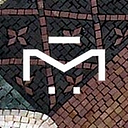Safety, mosaic masks, & statement-making in the face of the pandemic
Ahhhh the joys of 2021… Presidential public speeches every three days, social distancing, doctor’s warnings, scientific monologues, makeshift offices, and of course, home food deliveries. Everything to stop the C-bug from spreading like a wildfire especially face masks.
Needless to say, at this point masks have become an integral part of our everyday lives. Surgical masks, colorful cotton masks, masks with filters, plastic masks — you name it. The bug just keeps mutating and spreading, so the masks are here to stay, at least for a while longer. Judging by the state of things, they will become the cultural heritage for future generations, simply because they are beneficial on so many fronts. They don’t just slow down the spreading of the c-bug, but they also protect us from other viruses and bacteria, they are good for covering zits, you don’t have to shave every day, and you will save some money on make-up. So for all of those anti-maskers out there — What’s wrong with you?!
And the history of masks is long and vast. They once had a much different and more fun purpose. They were used in ancient rituals, medical ceremonies, and festive occasions. So once upon a time, people used masks to fulfill fertility rites, funerary customs, and, get this, CURE SICKNESS. Uh-huh. Thousands of years ago, people were on to something…
Masks that represented harmful spirits were often created and used to keep a certain balance of power, and traces of that custom can be found in many secret society rituals today. For example, in New Britain, members of a secretive terrorist society known as Dukduk wore to judge and execute offenders. The masks usually depicted aggressive supernatural spirits and were made from a variety of materials such as tapa, pith, etc.
Masks were made from a variety of materials, often wood, cloth, plaster, dried grass, human and animal bones, etc. They were either simple, covered with pigments, or deeply intricate in details. Some of the most gorgeous masks that have been preserved to this day are mosaic artwork masks created of a huge array of different materials, a unique testament to the innovative spirit and creativity of the ancient people.
On the other hand, religious and spiritual rituals involving masks were mostly nocturnal. Masks worn for religious rituals served as reminders of the respective tribes’ ancestorial legacy, so they represented gods, deities, or ancestors themselves. In West Africa, all of the masks were highly realistic and they represented ancestors in their particular cultural roles.
You may not be familiar with the above-mentioned mask, but you’ve surely seen some of the stylized golden masks of the mummies of ancient Egyptians. These gorgeous funerary masks served to lead the spirit of the deceased to its final resting place.
Today, masks are used in pop culture through movies (Ghostface, Leatherface, Jason Vorhees…), for festive purposes, and in sports such as American football, hockey, etc. In the past, you needed an occasion or a role to wear a mask and not look like a madman, but today … you get to look like a madman every day! Lo., just kidding. These days, wearing a face mask shows people that you care about them and that your moral compass is pointed exactly where it should be.
So do whatever you like with your mask — just don’t take it off! Bedazzle it, make a mosaic artwork on it, hang your fav earing in the corner, put a flower through the clip — the possibilities are endless.
